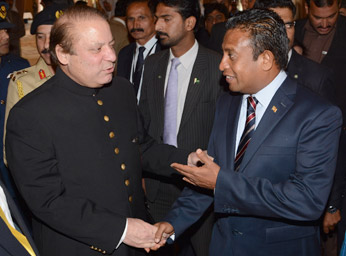Asia prospers economically - Deputy Speaker
Deputy Speaker Chandima Weerakkody said the remarkable economic
growth in Asia and its continuing growth rate are the outstanding
features of the Asian Century. Asia represents some of the world's most
vibrant and stable democracies.
|

Deputy Speaker Chandima Weerakkody with Pakistani Prime Minister
Nawaz Shariff on the sidelines of the meeting |
The Deputy Speaker made these observations on the topic of "Asian
Century: Cooperation on Economy, Energy and Environment" at the 6th
Asian Parliamentary Assembly (APA) Plenary Session held in Islamabad,
Pakistan recently.
Asian countries were more and more integrated than ever before
considering common issues in the broader context of economic integration
rather than a single country.
Once an Indian Strategic analyst Brahma Chellaney said that "whereas
Asia's coming together economically, it is not coming together
politically". Nevertheless, trade has integrated all the major economies
of Asia.
He said the West is looking at Asia because Asian economies provide a
lot of economic opportunities. Asia attracts Foreign Direct Investments
(FDI) in a massive way. Asia's role is important in shaping tomorrow's
world.
According to ADB, Asia's GDP would increase from $17 trillion in 2010
to $ 174 trillion in 2050 or half of the global GDP. Economic forecast
highlighted the trend towards China becoming the largest and India the
second largest economies by the year 2050 in terms of GDP. By 2050, the
East Asian and South Asian economies will grow by over 20 times, he
said.
Weerakkody said being the most populous region, South Asia's energy
reserves were very low, particularly for oil and gas reserves,
respectively 0.5 percent and 0.8 percent of the world's total oil and
gas reserves. By contrast, Central and West Asia was 4.1 and 5.6 percent
respectively.
These figures show an unequal distribution of energy in different
regions of Asia. Asia's energy picture urges regional cooperation and
adoption of strategies at national, subregional and regional levels to
realise the Asian Century by achieving sustainable economic growth. In
the resource-constrained future, isolated policy action at the national,
sub national or sub regional levels cannot resolve many issues in the
region of Asia.
It needs cross-border coordination between national governments,
collaboration between national and local governments as well as creation
of institutions that can support and enable consultation with
stakeholders including their views or concerns, the Deputy Speaker said.
|

